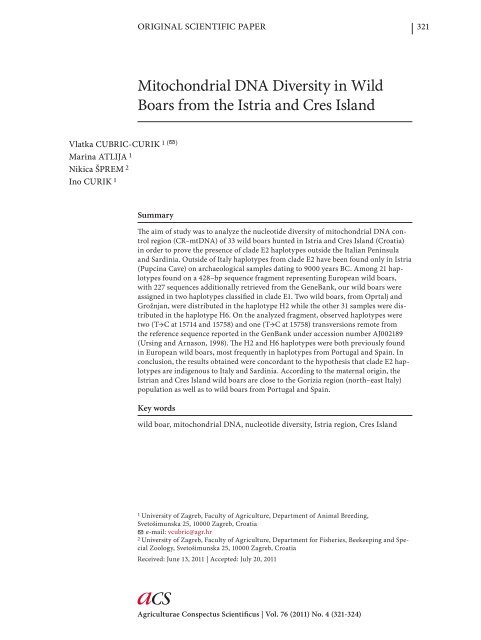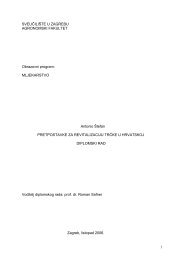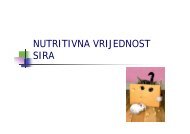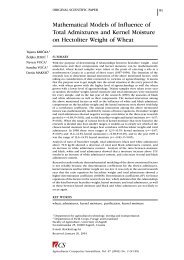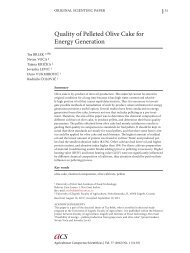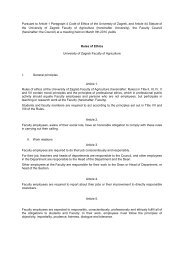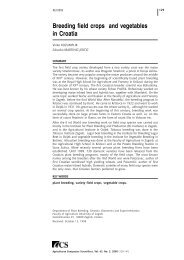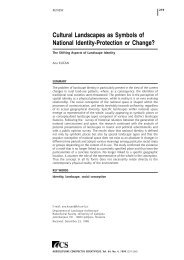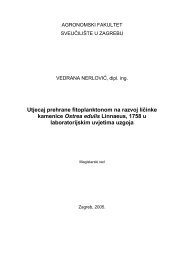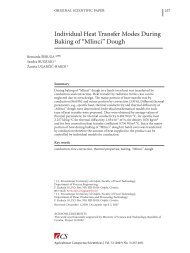Mitochondrial DNA Diversity in Wild Boars from the Istria and Cres ...
Mitochondrial DNA Diversity in Wild Boars from the Istria and Cres ...
Mitochondrial DNA Diversity in Wild Boars from the Istria and Cres ...
Create successful ePaper yourself
Turn your PDF publications into a flip-book with our unique Google optimized e-Paper software.
<strong>Mitochondrial</strong> <strong>DNA</strong> <strong>Diversity</strong> <strong>in</strong> <strong>Wild</strong> <strong>Boars</strong> <strong>from</strong> <strong>the</strong> <strong>Istria</strong> <strong>and</strong> <strong>Cres</strong> Isl<strong>and</strong>323Table 1. Polymorphic nucleotide positions with<strong>in</strong> 428–bp fragment of <strong>the</strong> mitochondrial <strong>DNA</strong> control region found <strong>in</strong> 260 wildboars sampled <strong>in</strong> different European countries. Nucleotide positions are numbered accord<strong>in</strong>g to <strong>the</strong> reference sequence GenBankAJ002189 (Urs<strong>in</strong>g <strong>and</strong> Arnason, 1998)Haplotypes 411-bp fragment(Alves et al. 2010)H1 (AJ002189) S035, S119 T T T T A A A C T A C T A C A T A G TH2 S022, S023, S029 . . . C . . . . C . . . . . . . . .H3 S085 . . . . . . . . C . T . . . . . . . .H4 S085 . . . . . . . . C . T . G . . . . . .H5 S021 . . . C . . . . . . . . G . . . . . .H6 S021, S083 . . . C . . . . . . . . . . . . . . .H7 S115 . . . C . . . . C G . . . . . . . . .H8 S056 . . . . . . . . C G . . . . . . . . .H9 S029 . . . C . . . . C . . . . . G . . . .H10 S117 C . . C . . . . . . . . . . . . . . .H11 S116 . . . C G . . . C G . . . . . . . . .H12 S054 . . . C G . . . C . . . . . G . . . .H13 S117 . . . C . . . T C . . . . . . . . . .H14 . . . . . . G . C . T . . . . . . . .H15 . . . C . . G . C . . . . . . . . . .H16 . . . C . . . . C . . . G . . . . . .H17 . C . C . G . T . . T C . T . . G . .H18 S011 . . C . . G . . . . . . G . . C G . GH19 . C . C . G . T . . T C . T . . G . GH20 S069, S012 . . C . . G . . C . . . G . . C G . GH21 S012 . . C . . G . . C . . . G . . C G T G15674156751571115714157231572915737157411575815822158251584015878158871593615995160101603216045Table 2. Distribution of haplotype frequencies of <strong>the</strong> 428–bpfragment of <strong>the</strong> mitochondrial <strong>DNA</strong> control region <strong>in</strong> 260 wildboars sampled <strong>in</strong> different European countriesHaplotype Portugal Spa<strong>in</strong> Austria France Italy/R Italy/G Croatia TotalH1 3 1 4H2 7 14 2 35 2 60H3 3 2 5 10H4 2 2H5 1 18 19H6 3 10 1 31 45H7 3 15 18H8 8 8H9 14 14H10 1 1H11 11 11H12 16 16H13 5 5H14 6 6H15 9 9H16 7 7H17 13 13H18 6 6H19 2 2H20 3 3H21 1 1Italy/R refers to all regions <strong>in</strong> Italy except Gorizia;Italy/G refers to <strong>the</strong> north-eastern Italian region, Gorizia<strong>the</strong>r research, we propose a hypo<strong>the</strong>sis that wild boars populationsplaced <strong>in</strong> <strong>Istria</strong>, <strong>Cres</strong> Isl<strong>and</strong>, Slovenia <strong>and</strong> Goriza form onepopulation. Still, this hypo<strong>the</strong>sis has to be tested with analysesbased on nuclear markers such as microsatellites or/<strong>and</strong> SNPs.Unfortunately, on <strong>the</strong> sequence analyzed, we were not ableto make dist<strong>in</strong>ction between S022, S023 <strong>and</strong> S029 (here H2) norbetween S021 <strong>and</strong> S083 (here H6) that would provide more <strong>in</strong>formativeresults. Thus, we plan to extend our analyses to <strong>the</strong> largenumber of wild boars distributed all over Croatia <strong>and</strong> neighbor<strong>in</strong>gcountries as well as to a larger mt<strong>DNA</strong> sequence fragment.ConclusionsIn analyses performed on <strong>the</strong> 33 wild boars hunted <strong>in</strong> <strong>Istria</strong><strong>and</strong> <strong>Cres</strong> Isl<strong>and</strong>, we have observed two haplotypes (H2 <strong>and</strong> H6),both, identified as haplotypes of E1 clade that is known to bepresent <strong>in</strong> European wild <strong>and</strong> domestic pigs. While we cannotexclude <strong>the</strong> possibility that clade E2 occurs at a low frequency<strong>in</strong> Croatia, <strong>the</strong> results obta<strong>in</strong>ed here fur<strong>the</strong>r support <strong>the</strong> <strong>in</strong>digenousstatus (Italy) of <strong>the</strong> clade E2. Fur<strong>the</strong>rmore, of <strong>the</strong> resultsobta<strong>in</strong>ed <strong>in</strong>dicate drastic changes <strong>in</strong> <strong>the</strong> maternal orig<strong>in</strong> of <strong>the</strong>wild boars <strong>in</strong> <strong>Istria</strong> <strong>and</strong> <strong>Cres</strong> Isl<strong>and</strong> dur<strong>in</strong>g last 11000 years.Obta<strong>in</strong>ed results also po<strong>in</strong>ted to <strong>the</strong> closeness of <strong>the</strong> maternalorig<strong>in</strong> between wild boars hunted <strong>in</strong> north–eastern Italy (Gorizia)<strong>and</strong> those hunted <strong>in</strong> <strong>Istria</strong> <strong>and</strong> <strong>Cres</strong> Isl<strong>and</strong>, leav<strong>in</strong>g possibility<strong>the</strong>y might form one population.ReferencesAlves P. C., P<strong>in</strong>heiro I., God<strong>in</strong>ho R., V<strong>in</strong>cente J., Gortázar C.,Sc<strong>and</strong>ura M. (2010). Genetic diversity of wild boar populations<strong>and</strong> domestic pig breeds (Sus scrofa) <strong>in</strong> South–western Europe.Biol J L<strong>in</strong>nean Soc 101: 797–822.Giuffra E., Kijas J. M. H., Amarger V., Carlborg Ö., Jeon J.T., Andersson L. (2000). The Orig<strong>in</strong> of <strong>the</strong> Domestic Pig:Independent Domestication <strong>and</strong> Subsequent Introgression.Genetics 154: 1785–1791.Agric. conspec. sci. Vol. 76 (2011) No. 4
324 Vlatka CUBRIC-CURIK, Mar<strong>in</strong>a ATLIJA, Nikica ŠPREM, Ino CURIKKim K. I., Lee J. H., Li K., Zhang Y. P., Lee S. S., Gongora J., MoranC. (2002). Phylogenetic relationship of Asian <strong>and</strong> European pigbreeds determ<strong>in</strong>ated by mitochondrial <strong>DNA</strong> D–loop sequencepolymorphism. Anim Genet 33: 19–25.Kimura M. (1980). A simple method for estimat<strong>in</strong>g evolutionaryrate of base substitutions through comparative studies of nucleotidesequences. J Mol Evol 16: 111–120.Larson G., Dobney K., Albarella U., Fang M., Matisoo–Smith E.,Rob<strong>in</strong>s J., Lowden S., F<strong>in</strong>layson H., Br<strong>and</strong> T., Willerslev E.,Rowney–Conwy P., Andersson L., Cooper A. (2005). Worldwidephylogeography of wild boar reveals multiple centers of pigdomestication. Science 307: 1618–1621.Larson G., Albarella U., Dobney K., Rowley–Conwy P., Schibler J.,Tresset A., Vigne J. D., Edwards C. J., Schlumbaum A., D<strong>in</strong>uA., Balacsescu A., Dolman G., Tagliacozzo A., Manaseryan N.,Miracle P., Van Wijngaarden–Bakker L., Masseti M., BradleyD. G., Cooper A. (2007). Ancient <strong>DNA</strong>, pig domestication, <strong>and</strong><strong>the</strong> spread of <strong>the</strong> Neolithic <strong>in</strong>to Europe. Proc Nat Acad Sci 104:15276–15281.Lattuada L., Quaglia F., Iannelli F., Gissi C., Mantecca P., BacchettaR., Polli M. (2009). <strong>Mitochondrial</strong> <strong>DNA</strong> sequence variations <strong>in</strong>some Italian wild boar populations. J Anim Breed <strong>and</strong> Genet126: 154–163.Librado P., Rozas J. (2009). DnaSP v5: a software for comprehensiveanalysis of <strong>DNA</strong> polymorphism data. Bio<strong>in</strong>formatics 25:1451–1452.Montiel–Sosa J. F., Ruiz–Pes<strong>in</strong>i E., Montoya J., Roncalés P., López–Pérez M.J., Pérez–Martos A. (2000). Direct <strong>and</strong> highly species–specific detection of pork meat <strong>and</strong> fat <strong>in</strong> meat products by PCRamplification of mitochondrial <strong>DNA</strong>. J Agricult Food Chem 48:2829–2832.Sc<strong>and</strong>ura M., Lacol<strong>in</strong>a L., <strong>Cres</strong>tanello B., Pecchioli E., Di BenedettoM. F., Russo V., Davoli R., Apollonio M., Bertorelle G. (2008).Ancient vs. recent processes as factors shap<strong>in</strong>g <strong>the</strong> genetic variationof <strong>the</strong> European wild boar: are <strong>the</strong> effects of <strong>the</strong> last glaciationstill detectable? Mol Ecol 17: 1745–1762.Sc<strong>and</strong>ura M., Iacol<strong>in</strong>a L., Apollonio M. (2011). Genetic diversity <strong>in</strong><strong>the</strong> European wild boar Sus scrofa: phylogeography, populationstructure <strong>and</strong> wild x domestic hibridization. Mamm Rev41: 125–137.Šprem N. (2009). Morphological <strong>and</strong> genetic characteristics of wildboars (Sus Scrofa, L.) <strong>in</strong> Republic of Croatia. Doctoral dissertation,University J. J. Strossmayer <strong>in</strong> Osijek, Osijek.Tamura K., Dudley J., Nei M., <strong>and</strong> Kumar S. (2007). MEGA4:Molecular Evolutionary Genetics Analysis (MEGA) softwareversion 4.0. Mol Biol Evol 24: 1596–1599.Urs<strong>in</strong>g B. M., Arnason U. (1998). The complete mitochondrial <strong>DNA</strong>sequence of <strong>the</strong> pig (Sus scrofa). J Mol Evol 47: 302–306.acs76_62Agric. conspec. sci. Vol. 76 (2011) No. 4


